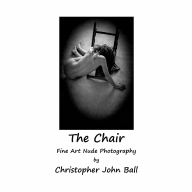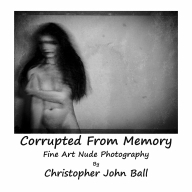|

Photography Articles, Essays and Tutorials by Christopher John Ball:
|
|  |
-
THE
TORMENT OF ARIAS : THE PHOTOGRAPHY OF JEAN JACQUES ANDRÉ
If one were to attempt to describe the photographs
that Jean creates it would be in terms of a fusion of the images
produced by Angus McBean (his theatrical photomontages), Ralph
Gibson (particularly his ‘The Somnambulist’ 1970
era) and the Symbolist artists such as Gustave Moreau, Rodolphe
Bresdin and Fernand Khnopff - writes Christopher John Ball
-
THE
PHOTOGRAPHIC ECSTASY: THE PHOTOGRAPHY OF DANIEL MURTAGH
Just as he enjoys using female models to create much of his
still imagery - Daniel predominantly casts women in the film
roles because “there is an ideal balance to be found by
expressing emotion and sensuality with woman as protagonist.”
Asked to expand further he explains that he believes that women
have “a face that looks out from some aspect of human
experience I can never really know” - writes Christopher
John Ball.
-
PHOTOGRAPHY
AND THE OTHER - “ONCE YOU LABEL ME, YOU NEGATE
ME” Much has been written by
philosophers, such as Aristotle, Immanuel Kant and Wittgenstein,
about the nature of beauty, aesthetics and the ever shifting
values that we place upon what we see and observe; but what
does it mean to be ‘seen’ by another and how does
that impact upon us as individuals and how we perceive ourselves
and our own appearance/beauty?
-
PRACTICAL
DREAMER - THE PHOTOGRAPHY OF NICOLAS TUCKER
Nic is on record as stating that he doesn’t see his work
as an… “abstract, a symbol or a statement…I’m
trying to make a decent picture, nothing more serious than that”
but there is far too much going on within his imagery, too many
references, quotations, symbolism and delightful constructs,
for this to be anything more than just a playful conceit and
further example of his self deprecating humour and, in truth,
could possibly be a disservice to his work. The viewer is drawn
into his images and encouraged to ask questions – to enter
into a dialogue. His photographs are inherently about the sensuality
and eroticism of looking and they refuse to be ignored - writes
Christopher John Ball.
-
AN
INTRODUCTION TO PHOTOGRAPHIC FILTERS AND THEIR APPLICATION
Filters are used within photography to modify the light falling
on the subject or passing through the camera lens. Even though
we are now in the digital age and see the widespread use of
photoshop, filters still have their uses and it doesn't hurt
to have an understanding of how they work or can be used. -
writes Christopher John Ball
-
CYANOTYPES
AND DIGITAL NEGATIVES
I favour making negatives via an inkjet printer and printing
out to the desired size onto Overhead Projection Film. Inkjet
negatives give the photographer greater control over the finished
image - writes Christopher John Ball
-
-
-
A
SHORT INTRODUCTION TO THE KALITYPE PROCESS
The Kallitype is another process that uses ferric
salts with silver nitrate and produces a brown-tone image. It
was introduced by Dr. W. J. Nichol in 1899 and was based on
Herschel's argentotype (1842). It is similar in appearance to
a platinotype but is formed of a metallic silver instead of
platinum - writes Christopher John Ball
-
HOW
TO USE EXPOSURE METERS
Though almost all of today's cameras come with
a 'built-in' light meter this doesn't mean that the good old
fashioned 'hand-held' meter should be thrown away as useless
- writes Christopher John Ball
-
A
SHORT INTRODUCTION TO THE GUM BICHROMATE PROCESS
The gum bichromate process draws on techniques first developed
by Alphonse Louis Poitevin in 1855. It was in this year that
he patented a process he called 'helio-plastic'. He had found
that when bichromated gelatine was exposed to a light, strong
in UV, under a negative and then soaked in water; parts of the
gelatine stood out in relief to form an image. This was because
the bichromated colloid had undergone a hardening process, making
it more or less insoluble, in proportion to the action of light
- writes Christopher John Ball
-
DEPTH
OF FIELD - When one focuses a camera upon a subject,
to give a sharp image, objects nearer to the lens, and those
further away from it, do not appear equally sharp. This decline
in sharpness is gradual and progressive. There exists an area
of apparent focus, both behind and in front of the subject,
where the blur is too small to be noticeable and therefore appears
sharp. This area, between the furthest and nearest parts of
a subject that be photographed with acceptable sharpness, is
known as the ' depth of field '.
-
DEPTH
OF FOCUS -
When the camera lens is focused on an object there is one position
where the image is sharpest. The sharpness falls off as the
film is moved away from this position of exact focus. There
is a certain range of focusing movement within which it is not
possible for the human eye to detect a difference between what
is actually sharp and a very slightly blurred, or soft, image.
In photography this is called depth of focus.
-
HYPERFOCAL
DISTANCE - When a lens is focused on infinity,
the depth of field extends from infinity towards a point nearer
the camera lens. This distance from the camera to the near limit
of sharp field is called the Hyperfocal distance.
-
A
SHORT INTRODUCTION TO THE CASEIN PROCESS
-This is a process that was patented
by the Neue Photographische Gesellschaft in 1908. Casein, the
main protein in milk, can be used in combination with a dye
or pigment and potassium dichromate to make prints - writes
Christopher John Ball
-
PHOTOGRAPHIC
CHEMICALS
- Descriptions of the various chemicals most
used within conventional photography. Includes details of any
health threats. Please
note: All medical suggestions are for information and advice
only. On all occasions please seek medical help, from a Doctor,
immediately. Remember to take any packaging, bottles, descriptions
etc to the hospital
-
HOW
TO DEVELOP A MONOCHROME FILM.Whilst
it may seem that digital has made film redundant many serious
photographers are coming back to the medium or looking to try
it for the first time. If you are one of them then this short
article will give you some tips on how to process your first
film - writes Christopher John Ball.
-
-
A
BRIEF EXPLANATION OF THE ZONE SYSTEM
The Zone System is a method of exposing, developing, and printing
monochrome images and is based upon pre-visualising the subject
matter - writes Christopher John Ball
-
THE
PIN-HOLE CAMERA
In this day of digital perfection and software correction the
'Pin-hole' camera is a breath of fresh air and a superb tool
to consider using on your next photographic assignment - suggests
Christopher John Ball
-
A
SHORT INTRODUCTION TO THE ALBUMEN PROCESS
Until
1850 prints had traditionally been made on salted paper (paper
that had been impregnated with Silver Chloride) that had been
coated with a solution of Silver Nitrate. This process was thought
to have little strength. A base that could hold more silver
was required. Blanquart-Evrard, of Lille, suggested coating
the paper with a thin film of egg white (Albumen) prior to sensitising
with a Silver Nitrate solution -writes Christopher John Ball
-
-
A
SHORT INTRODUCTION TO THE PLATINUM PHOTOGRAPHIC PROCESS
- The platinum print has been called the most beautiful
photographic process. It has a naturally warm colour and a greater
tonal separation in the mid tones and highlights.Please
note that this method of printing is expensive and can be complicated.
Therefore this page can only give a brief overview - writes
Christopher John Ball.
-
-
INTRODUCTION
TO MAKING A SUCCESSFUL PHOTOGRAPHIC TEST STRIP/PRINT
Though it is possible to purchase an 'exposure meter' for calculating
print exposure times these can be expensive and, for fine art/exhibition
printing, not always accurate. By far the best way to ascertain
the correct exposure for any given negative/paper type is to
produce a test strip - writes Christopher John Ball
-
|










